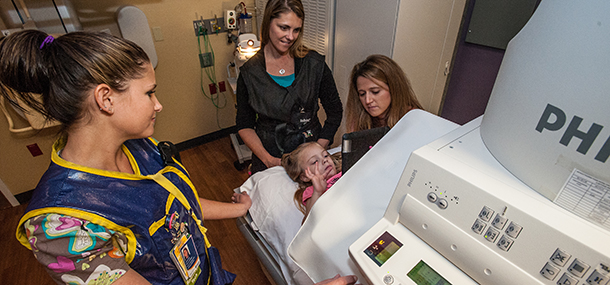
Chances are that if your child has had more than one urinary tract infection (UTI), then his or her doctor has ordered an x-ray VCUG or a nuclear cystogram. A VCUG is the abbreviation for a commonly performed imaging procedure called the Voiding CystoUrethreoGram. In 2014, our Radiology Department performed over 1240 VCUGs.
Pediatricians, family physicians and urologists use the VCUG to look at your child’s bladder and urinary tract system. During a VCUG, a radiologist uses a special kind of x-ray camera called fluoroscopy to take live action x-ray pictures of your child’s bladder as it fills and empties. A clear liquid called contrast is used to fill your child’s bladder so that it can be seen on the fluoroscopy images and used to determine if there are any structural or anatomy concerns.
In order to do a VCUG, a catheter tube needs be placed into your child’s bladder. In our Radiology Department, we use very small catheters and clean the urethral opening where the urine comes out before slipping in the catheter. Our staff is specially trained at placing catheters in babies, children and adolescents and follows strict rules to ensure your child’s safety during the procedure. Most children react to the cold sensations during the cleaning process and often describe the catheter placement as a strong urge to urinate. Most children are able to calm down after the catheter is in place and secured with a piece of tape.

The catheter is important because it is connected to the contrast water that flows into your child’s bladder. The radiologist moves the fluoroscopy camera above your child’s belly to take the images, watching as the bladder fills up and then watching as your child pees that contrast water out. A VCUG is most commonly used to diagnosis kidney reflux or vesicoureteral reflux (VUR). This is seen when the contrast water moves backward from the bladder up the ureters toward the kidneys. VUR is given a number grade from 1-5 with 1 being the slightest to 5 being the greatest amount of kidney reflux. This grading helps your child’s doctor to determine the best treatment plan. Other anomalies of the urinary tract system can also be seen using the imaging from a VCUG.
A VCUG is a very safe procedure for children of all ages. However, our radiology staff understands that it is a test that can cause parents and children to feel worried. We will provide you and your child with information about the procedure in ways that ensure your understanding, answer your questions and help you to feel supported during the procedure. Privacy concerns will be respected and we will do everything that we can to help make you and your child feel more comfortable during the VCUG.
Child life specialists at the Main Campus and at Liberty Campus are also available to provide more specialized developmentally appropriate preparation and offer other support resources to help your child positively cope during the procedure.
Story contributed by Dr. Mantosh S. Rattan and edited by Catherine Leopard, (Child Life Specialist).